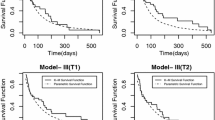Abstract
The emphasis of conventional survival research methods has historically been on the occurrence of failures over time. The lack of knowledge of related observed and unobserved covariates during the study of such events can have negative consequences. Frailty models are a viable option for investigating the impact of unobserved covariates in this context. In this article, we suppose that frailty multiplies the hazard rate. As a useful method to ensure the effect of unobserved heterogeneity, we propose weighted Lindley (WL) frailty models with generalized Weibull (GW) and generalized log-logistic-II (GLL2) as the baseline distributions. The Bayesian paradigm of Markov Chain Monte Carlo (MCMC) methodology is used to estimate the model parameters. Subsequently, model comparisons are performed via Bayesian comparison techniques. The popular kidney data set is considered to illustrate the results. It is shown that the new models perform better than those based on gamma and inverse Gaussian frailty distributions.



Similar content being viewed by others
References
Bacon RW (1993) A note on the use of the log-logistic functional form for modeling saturation effects. Oxf Bull Econ Stat 55:355–361
Calabria R, Pulcini G (1996) Point estimation under asymmetric loss functions for left-truncated exponential samples. Commun Stat Theory Methods 25(3):585–600
Chacko M, Mohan R (2018) Bayesian analysis of Weibull distribution based on progressive type-II censored competing risks data with binomial removals. Comput Stat 34(4):233–252
Chen MH, Shao QM (1999) Monte Carlo estimation of Bayesian credible intervals and HPD intervals. J Comput Graph Stat 8(1):69–92
Clayton’s DG (1978) A model for association in bivariate life tables and its applications to epidemiological studies of familial tendency in chronic disease incidence. Biometrica 65:141–151
Cox DR (1972) Regression models and life tables (with discussion). J R Stat Soc Ser B 34:187–220
Deshpande JV, Purohit SG (2005) Life time data: statistical models and methods. World Scientific, New Jersey
Hanagal DD (2008) Frailty regression models in mixture distributions. J Stat Plan Inference 138(8):2462–2468
Hanagal DD (2019) Modeling survival data using frailty models, 2nd edn. Springer, Singapore
Hanagal DD, Dabade AD (2013) Modeling of inverse Gaussian frailty model for bivariate survival data. Commun Stat Theory Methods 42(20):3744–3769
Hanagal DD, Dabade AD (2015) Comparison of shared frailty models for kidney infection data under exponential power baseline distribution. Commun Stat Theory Methods 44(23):5091–5108
Hanagal DD, Pandey A (2014) Inverse Gaussian shared frailty for modeling kidney infection data. Adv Reliab 1:1–14
Hanagal DD, Pandey A (2015) Gamma frailty models for bivariate survival data. J Stat Comput Simul 85(15):3172–3189
Hanagal DD, Pandey A (2017) Shared inverse Gaussian frailty models based on additive hazards. Commun Stat Theory Methods 46(22):11143–11162
Hanagal DD, Sharma R (2013) Modeling heterogeneity for bivariate survival data by shared gamma frailty regression model. Model Assist Stat Appl 8:85–102
Hanagal DD, Sharma R (2015a) Bayesian inference in Marshall-Olkin bi-variate exponential shared gamma frailty regression model under random censoring. Commun Stat Theory Methods 44(1):24–47
Hanagal DD, Sharma R (2015b) Comparison of frailty models for acute leukaemia data under Gompertz baseline distribution. Commun Stat Theory Methods 44(7):1338–1350
Hanagal DD, Sharma R (2015c) Analysis of bivariate survival data using shared inverse Gaussian frailty model. Commun Stat Theory Methods 44(7):1351–1380
Hougaard P (1985) Discussion of the paper by D.G. Clayton and J. Cuzick. J R Stat Soc A 148:113–114
Hougaard P (1991) Modeling heterogeneity in survival data. J Appl Probab 28:695–701
Hougaard P (2000) Analysis of multivariate survival data. Springer, New York
Ibrahim JG, Ming-Hui C, Sinha D (2001) Bayesian survival analysis. Springer, New York
Lindley DV (1958) Fiducial distributions and Bayes’ theorem. J R Stat Soc B 20:102–107
Mazucheli J, Coelho-Barros EA, Achcar JA (2016) An alternative reparametrization for the weighted Lindley distribution. Pesqui Oper 36(2):345–353
McGilchrist CA, Aisbett CW (1991) Regression with frailty in survival analysis. Biometrics 47:461–466
Mudholkar SG, Srivastava DK (1993) Exponentiated Weibull family for analyzing bathtub failure-rate data. IEEE Trans Reliab 42(2):299–302
Mudholkar SG, Srivastava DK, Kollia GD (1995) The exponentiated Weibull family: a reanalysis of the bus-motor-failure data. Technometrics 37(4):436–445
Mudholkar SG, Srivastava DK, Kollia GD (1996) A generalization of the Weibull distribution with application to the analysis of survival data. J Am Stat Assoc 91(436):1575–1583
Oakes D (1989) Bivariate survival models induced by frailties. J Am Stat Assoc 84(406):487–493
Pandey A, Bhushan S, Pawimawha L, Tyagi S (2020) Analysis of bivariate survival data using shared inverse Gaussian frailty models: a Bayesian approach. Predictive analytics using statistics and big data: concepts and modeling, vol 14. Bentham Books, Sharjah, pp 75–88
Santos CA, Achcar JA (2010) A Bayesian analysis for multivariate survival data in the presence of covariates. J Stat Theory Appl 9:233–253
Vaupel JW, Manton KG, Stallaed E (1979) The impact of heterogeneity in individual frailty on the dynamics of mortality. Demography 16:439–454
Acknowledgements
We would like to express our gratitude to the reviewers for taking the time to read and remark on our manuscript; their suggestions helped us enhance it.
Author information
Authors and Affiliations
Corresponding author
Ethics declarations
Conflict of interest
No potential competing interest was reported by the authors.
Additional information
Communicated by Eduardo Souza de Cursi.
Publisher's Note
Springer Nature remains neutral with regard to jurisdictional claims in published maps and institutional affiliations.
Rights and permissions
About this article
Cite this article
Tyagi, S., Pandey, A., Agiwal, V. et al. Weighted Lindley multiplicative regression frailty models under random censored data. Comp. Appl. Math. 40, 265 (2021). https://doi.org/10.1007/s40314-021-01666-5
Received:
Revised:
Accepted:
Published:
DOI: https://doi.org/10.1007/s40314-021-01666-5
Keywords
- Bayesian estimation
- Frailty
- Generalized log-logistic distribution
- Generalized Weibull distribution
- Hazard rate
- MCMC
- Random censoring
- Weighted Lindley frailty




